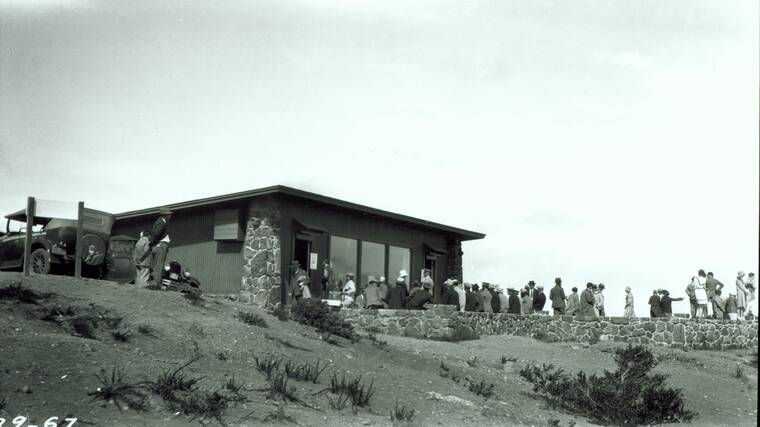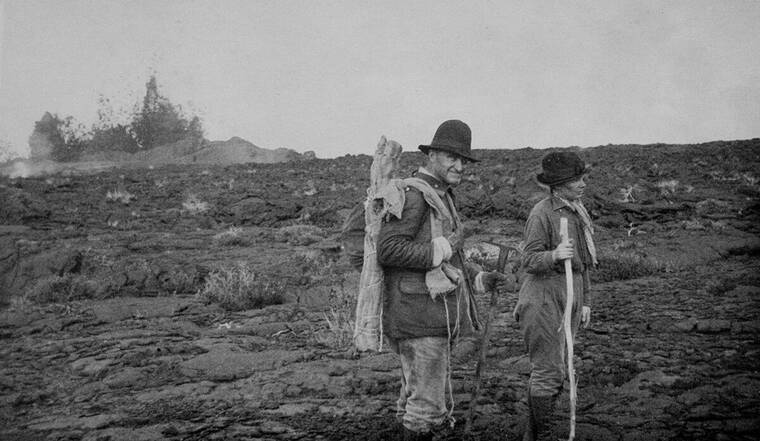For the first time in nearly a century, Kilauea summit will soon be without a museum.
Demolition began this month at the Thomas A. Jaggar Museum, ending a six-year period of disuse after the facility was critically damaged during the 2018 Kilauea eruption.
While work crews have experienced periodic delays due to inclement weather, and although their contract with Hawaii Volcanoes National Park gives them 600 days to complete the demolition, park spokeswoman Jessica Ferracane said the building, along with the adjacent Hawaiian Volcano Observatory structure, will be removed almost entirely in the coming weeks.
“For a lot of us, it’s really bittersweet to see them dismantled before our eyes like this,” Ferracane said. “For rangers especially, there are many memories of introducing countless visitors to Kilauea volcano here, recollections of cold, drizzly nights beneath the protective eaves of the building, as the lava lake glowed.”
The exhibits from Jaggar already have been removed and scattered to various places — some, such as a series of murals by the late Herb Kane, are on loan to the Pahoa Lava Zone Museum, while others have returned to the park’s collection. Still others are outdated and will not be displayed again.
Ferracane said the majority — about 80% to 90% — of building materials or other resources such as exhibit frames from the museum will be recycled.
When the demolition is complete, all that will remain at the buildings’ location at Uekahuna Bluff will be a few short stone walls and unobtrusive “interpretive displays” that have yet to be designed, Ferracane said.
“It is inspiring to envision what the natural landscape will look like,” Ferracane said, calling the site “the doorstep into the realm of the elemental forces of Pele.”
Ferracane explained that there have been no considerations for rebuilding a museum at the edge of Halema‘uma‘u Crater.
Uekahuna, Ferracane said, is the highest point at which to view the crater, but is also a site of deep cultural significance to Native Hawaiians — the place’s name translates roughly to “wailing priest,” with several folktales surrounding the location.
Instead, much of Jaggar’s function will be passed on to the Kilauea Visitor Center after a renovation planned to begin this year. The renovated and expanded KVC will include new exhibits incorporating geology, biology and Hawaiian culture.
Ferracane said that while the National Park Service has discussed the possibility of constructing a new museum at the park’s entrance, that idea was met with public resistance, with people concerned the amount of tree removal required for such a project would not be worth it.
The improvements to KVC also will expand its parking area, redo its bathroom facilities, and install a new roundabout at the park’s entrance to improve traffic flow.
Ferracane said the project will take about two years to complete, and will require the total closure of KVC.
In the meantime, temporary visitor education stations will be set up near the historic ballfields at Kilauea Military Camp.
Throughout the project, she said, parking and traffic likely will become more difficult within the park, particularly if another eruption happens during that time.
“We apologize, and we thank everyone for their patience,” Ferracane said.
Jaggar’s history
The demolition of the Jaggar Museum marks the end of a 97-year legacy.
The first museum at Uekahuna was built in 1927 by the Hawaii Volcano Research Association, a scientific organization formed in 1912 with the backing of various Hawaii businessmen and with Thomas Jaggar at the helm.
Jaggar, a professor at the Massachusetts Institute of Technology, led the HVRA and operated a small observatory at the rim of Halema‘uma‘u Crater until the National Weather Service took over operations in 1919. The U.S. Geological Survey took over management in 1924, and has operated the Hawaiian Volcano Observatory ever since.
The HVRA’s buildings at Uekahuna were a small museum and a lecture hall that also served as offices for HVO.
In the 1980s, the museum underwent significant renovations in conjunction with construction of a new HVO building next door. That renovation was completed in 1987.
The museum’s last day of operation was May 11, 2018, when the bulk of HVNP closed amid intense seismic activity caused by a major eruption of Kilauea.
Rocked by nearly constant earthquakes for months on end, the museum sustained significant structural damage, and after the caldera floor sunk by approximately 1,400 feet, the bluff was found to be too destabilized for the museum to safely resume operations after the park reopened in September 2018.
Ferracane said that HVNP does not track the exact number of visitors to specific areas of the park, so an exact number of visitors to the museum is not known. However, she estimated that it was likely commensurate with the total rate of daily park visitors.
Particularly in the years after the 2008 eruption began, Ferracane said the museum likely had more than 2 million visitors per year.
Email Michael Brestovansky at mbrestovansky@hawaiitribune-herald.com.








